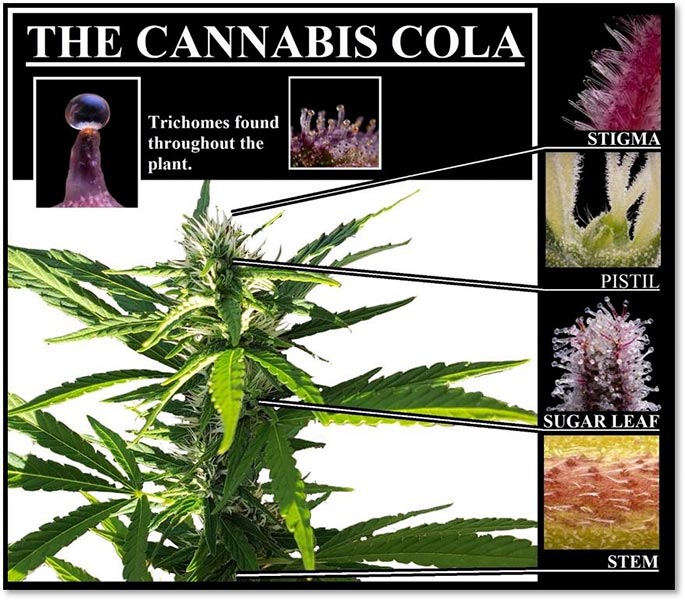Every female hemp plant is composed of nine main parts: cola, pistils, bracts, trichomes, sugar leaves, fan leaves, stem, branches and roots. The cola is the flowering portion of the plant, which is composed of many small floral clusters covered in trichomes. Hemp plants can be pruned and manipulated to produce more colas. The flowers are composed of pistils, structures with an ovule and two protruding styles capped with stigmas. The stigmas extend past the bract, the small leaves that surround the reproductive cells, to catch male pollen. Trichomes are hairlike appendages that contain cannabinoids and terpenes, the compounds currently most sought after by those growing for flower or extractions.
Paying attention to the trichome development is essential for harvesting hemp. The maturation of the trichomes is shown in the color of the stigmas. At first, the stigmas are a pale, translucent color, white or cream, sometimes tinged pink or purple. As these structures begin to dry out and by the time the bud is ripe, they will turn amber, brown or purple. The ovaries behind them will swell and seem to absorb the stigmas. The glandular trichomes develop taller structures and stand erect from the tissue. Precursors are manufactured into THC and CBD on the inner surface of the membrane. As THC and CBD build up in the glandular trichome, its shape changes. The thin stalk, which holds the head, swells and strains the membrane. The gland begins to look like a mushroom.
Glandular trichomes come in three main types:
- Bulbous
- Capitate-sessile
- Capitate-staIked
Bulbous trichomes are located throughout the Cannabis plant. Capitate-sessile trichomes have globular heads and are located on the underside of the sugar and fan leaves. Both bulbous and capitate-sessile trichomes are microscopic. Capitate-stalked trichomes are visible with the naked eye and resemble mushrooms, as they contain a large head atop a stalk. Nonglandular trichomes cover the stems, leaves, bracts and flowers. The longer and more profuse hairs cover the upper leaf surfaces, stems, petioles (the stalk that joins a leaf to a stem) and tepals. The shorter trichomes are restricted to the upper leaf surfaces (Dayanandan and Kaufman 1976).
Sugar leaves are small leaves that grow out of the buds within the cola. Their trichome covering gives them a sugar-coated appearance. Sugar leaves are sometimes harvested for their cannabinoid and terpene content. Fan leaves are the large, protruding leaves that cover the length of the plant. They are necessary for photosynthesis, but may be removed before harvest (The Different Parts of A Marijuana & Cannabis Plant 2020). The leaves of Cannabis are palmate (originate from a central point) with long, serrated leaflets. "The serrations along the margins are prominent, curved and pointed towards the tips of the leaf blades" (Raman et al. 2017) The stem, or stalk, is the main support structure of the Cannabis plant that transports fluids, nutrients and information from the roots to the rest of the plant. The points where the stem and leaves intersect are called nodes. Lastly, the roots anchor the plant, absorb water, dissolve minerals, and conduct these to the stem.

Figure 1. Anatomy of female Cannabis plant cola. Photo composed by Marysia Morawska
using photos by IG: @zoom gardens and Marysia Morawska.


